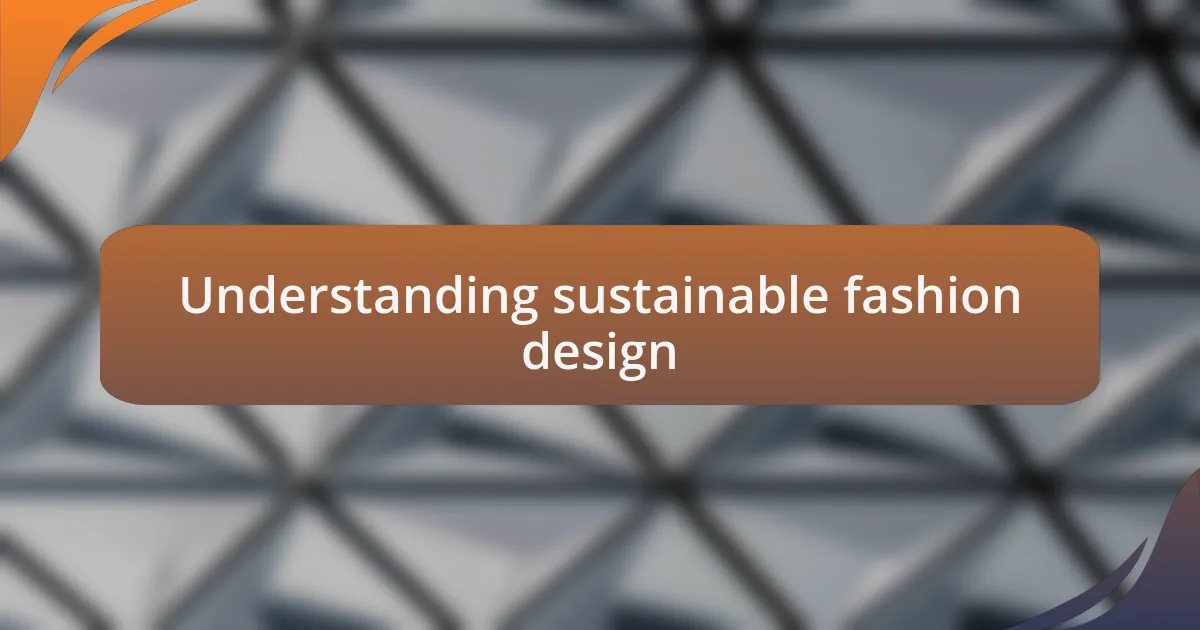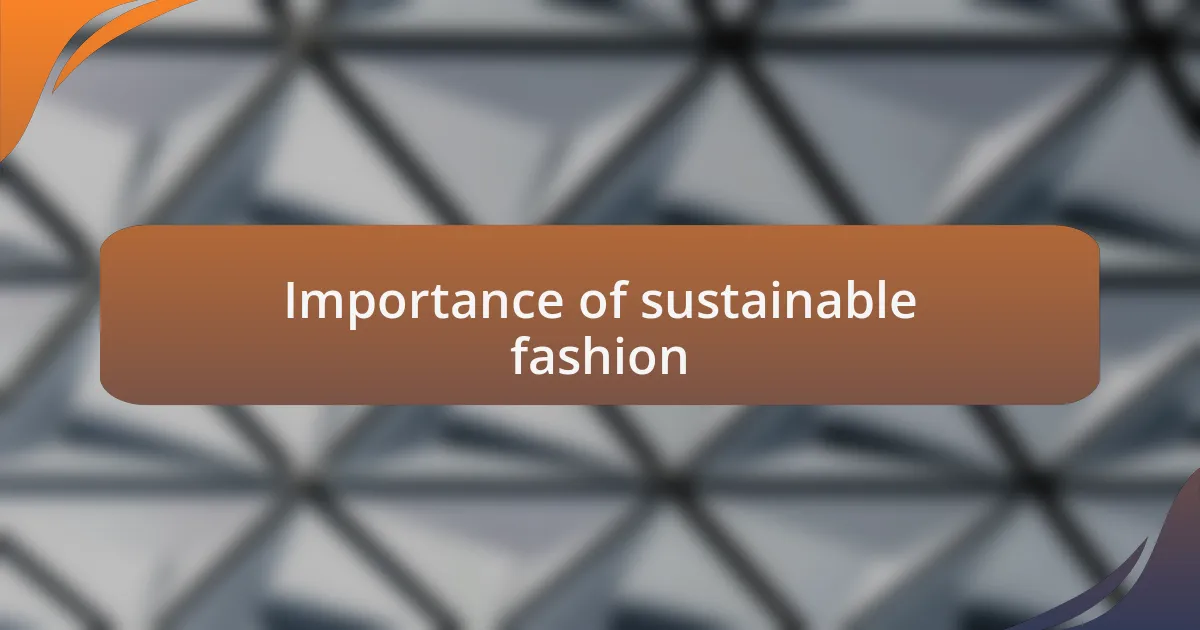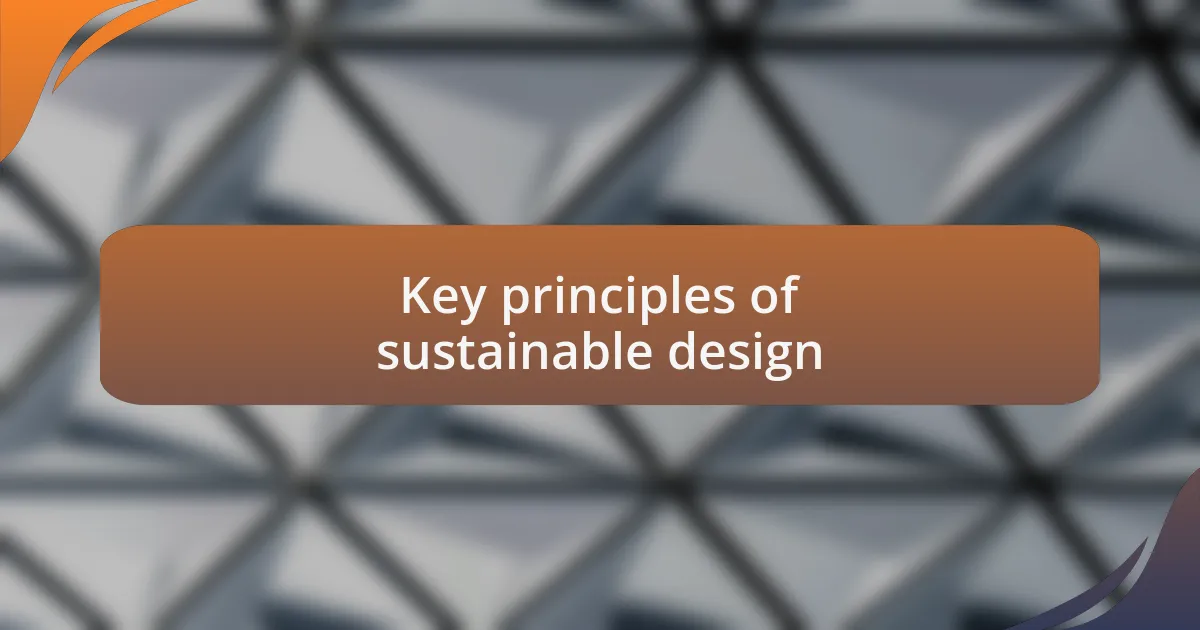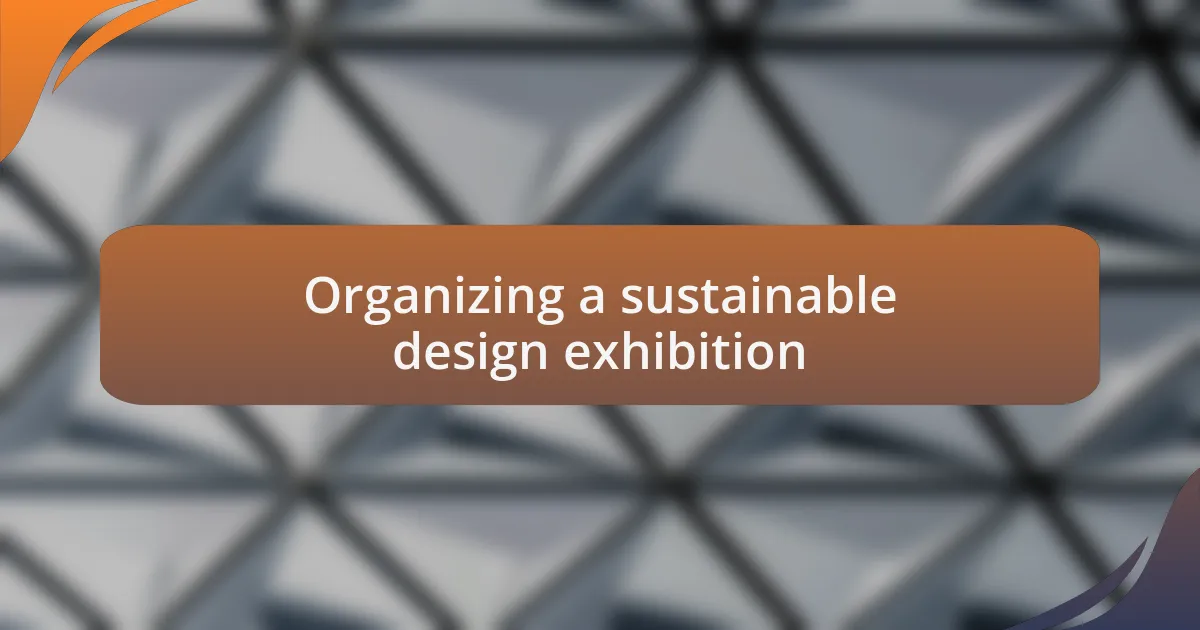Key takeaways:
- Sustainable fashion design emphasizes ethical production, environmental responsibility, and the importance of transparency in supply chains.
- Engaging with sustainable fashion fosters social responsibility and encourages consumers to develop a deeper appreciation for clothing as an art form rather than a commodity.
- Key principles of sustainable design include reducing waste, durability, and the potential for storytelling, creating emotional connections between consumers and garments.
- Patience, storytelling, and community engagement are crucial lessons learned in the journey toward promoting sustainable fashion practices.

Understanding sustainable fashion design
Sustainable fashion design is about creating clothing and accessories with a focus on ethical production and environmental responsibility. I remember the first time I held a garment made from organic cotton, feeling its softness while knowing it had a minimal impact on the planet. This experience opened my eyes to how our choices can align with our values, prompting me to ask: How often do we think about the impact of the fabrics we wear?
I’ve often found that sustainable fashion goes beyond materials; it’s about the entire life cycle of a product. For instance, when I encountered brands that emphasize transparency in their supply chains, I was amazed by the stories behind each piece. Isn’t it fascinating to think that every stitch carries a narrative, from the artisan who crafted it to the journey it took to reach us?
In my exploration of sustainable design, I realized that creativity can flourish within restrictions. Designing with limited resources has forced me to rethink traditional aesthetics, pushing me to innovate while remaining environmentally conscious. This journey has challenged me to ask: What can beauty look like when it prioritizes the planet and people over profit?

Importance of sustainable fashion
Sustainable fashion is crucial because it acknowledges the environmental crisis our planet faces today. I remember going to a thrift store for the first time; each piece of clothing I sifted through felt like a treasure trove of potential. This experience made me realize that every garment we choose can either contribute to or alleviate the burden on our resources and ecosystems. Have you ever thought about the impact of fast fashion on our landfills?
Beyond environmental benefits, sustainable fashion fosters social responsibility. I recall meeting a designer who worked closely with artisans in developing countries, ensuring they received fair wages and decent working conditions. It struck me that every purchase could empower someone across the world, turning fashion into a tool for positive change. Isn’t it amazing how our fashion choices can create ripple effects that extend far beyond our closets?
Moreover, embracing sustainable fashion encourages us to redefine our relationship with clothing itself. I often find myself curating a capsule wardrobe, focusing on pieces that I truly love and that tell a story. This intentionality cultivates a deeper appreciation for fashion as an art form, rather than a mere commodity. How liberating it is to realize that fashion can be about joy and quality, not just quantity!

Key principles of sustainable design
Key principles of sustainable design revolve around reducing waste and using eco-friendly materials. I once attended a workshop where one designer shared her journey of transforming discarded fabrics into stunning pieces. It was inspiring to see that sustainable design isn’t about what you have to leave behind; it’s about what you can create anew from what already exists. Have you ever thought about the stories that old textiles might tell?
Another fundamental principle is the idea of durability and longevity. I’ve learned that opting for timeless designs over fleeting trends leads to a more sustainable wardrobe. I remember investing in a beautifully crafted jacket that has not only outlasted many fashion phases but has also become a treasured part of my identity. Isn’t it rewarding to own something that stands the test of time?
Also, transparency in the supply chain plays a crucial role in sustainable design. When I began researching fashion brands, I was surprised to discover just how many didn’t disclose their manufacturing processes. I found greater satisfaction in supporting brands that openly shared their practices, knowing my purchases were part of a larger movement towards ethical responsibility. What if each of us made choices based on transparency? Wouldn’t that reshape the fashion landscape for the better?

Organizing a sustainable design exhibition
To organize a sustainable design exhibition, it’s essential to prioritize eco-friendly logistics throughout the planning phase. When I coordinated a small exhibition showcasing local sustainable designers, we chose venues that emphasized energy efficiency and incorporated natural lighting. The impact these choices had on the overall atmosphere was palpable; attendees commented on how the space felt alive, encouraging a deeper connection to the designs.
Another key aspect involves selecting exhibitors who share a commitment to sustainability. I remember reaching out to a brand that upcycled materials for their collections, and it brought such an authentic touch to our event. Their passion resonated with the audience, creating meaningful conversations about the importance of sustainable practices. Wouldn’t it be incredible if every exhibition featured stories that inspired attendees to rethink their own consumption habits?
Lastly, integrating educational components into the exhibition can greatly enhance the experience. During my last event, I arranged workshops led by sustainability advocates who offered insights and skills for reducing waste in everyday fashion. The enthusiastic responses from participants showed me that knowledge can ignite action; it proved that we are all capable of contributing to a more sustainable future. Isn’t it amazing how understanding the ‘why’ behind sustainable practices can motivate us to take steps toward change?

Highlights from my journey
One of the highlights from my journey into sustainable fashion has been witnessing the transformation in public awareness. I recall attending a panel discussion where a prominent designer spoke passionately about the impact of fashion on the environment. It struck me how vulnerable and exposed I felt as I realized my own habits contributed to this crisis. This moment was a reminder that we all have a role to play, and it motivated me to take my efforts in sustainability more seriously.
Another memorable experience occurred when I collaborated with a co-op that focuses on slow fashion. I was moved by the artisans’ dedication to their craft and how they poured their heart into each piece. There was a palpable energy in the room during one of our workshops, where we tried our hand at designing with sustainable materials. Seeing participants suddenly grasp the significance of their choices was incredibly fulfilling. Have you ever felt that rush when someone discovers a new passion? It’s a beautiful reminder that small actions can lead to profound change.
Lastly, developing partnerships with local eco-conscious brands has been a game-changer for me. I vividly remember working late nights with a team to curate our first sustainable fashion showcase. The excitement was contagious as we shared ideas and vision, aiming to create an event that resonated with our community. It taught me that collaboration amplifies impact; when like-minded individuals unite, it ignites creativity and inspires a movement. How many opportunities do we miss by not connecting with those who share our values?

Lessons learned from my experience
The most significant lesson I learned was the importance of patience in sustainable fashion. Early on, I rushed into projects, eager to make an impact overnight. However, I quickly realized that real change takes time and requires a considered approach. For instance, I remember a project that seemed like it was dragging on forever, yet it blossomed into one of my proudest achievements. It taught me that the slow and steady path often leads to more meaningful results.
Another key insight was understanding the power of storytelling. During one of my first exhibitions, I experimented with showcasing not just the garments but the stories behind them. I watched as visitors connected emotionally with the pieces, often asking questions about their origins. That’s when I understood that fashion isn’t just about the items; it’s about the narratives we weave around them. Have you ever shared a story that resonated so deeply that it changed someone’s perspective? I’ve seen how stories cultivate empathy and spark conversations, deepening the bonds between creators and consumers.
Finally, I learned the value of actively listening to the community. At a local event, I had the chance to engage directly with customers and fellow creators, and their feedback opened my eyes to new ideas. It was humbling to realize how much I don’t know and how crucial it is to be open to different perspectives. This experience reminded me that sustainable fashion is not just about one person’s vision; it’s a collaborative effort that thrives on inclusivity and shared insights. When was the last time you truly listened to someone’s experience? It’s these exchanges that can lead to unexpected breakthroughs in our journeys.